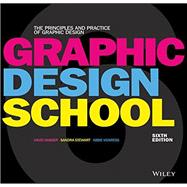The essential introduction to graphic design for the digital era
Graphic Design School provides a comprehensive introduction to visual design for modern media. From the fundamentals of design to advanced techniques and problem solving, this book is packed with practical advice and tutorials for a broad range of applications in any media. This updated sixth edition features a wealth of new guidance that reflects the evolution of the field, including extensive discussion of digital design and resourcing. New discussion tackles User Experience and User Interface Design, plus the latest tools, requirements, and resources for designing for the web, mobile apps, social media, and more. Updated assignments reflect the latest graphic design processes and guide students through the transition from simple solutions to starter portfolio pieces, while full-color illustrations, case studies, and designer biographies bring real-world perspective to this complex, multi-faceted skill.
As media continues to evolve, graphic designers must possess a core set of competencies that translate across all applications. This book teaches the critical concepts and essential skills that build the framework for successful, innovative design.
- Master the principles, elements, and tools of design
- Delve into typography, color, and layout for print and screen
- Understand coding requirements and information architecture
- Design for apps, social media, mobile devices, and more
Graphic design has never been a static field, and the continual honing of skills and techniques is an essential part of the job. Innovation comes from change, and today's design landscape is evolving at an ever-increasing pace—expanding diversity in media, audience, topic, technique, tools, and more offer unprecedented opportunity to make your mark. Graphic Design School equips you with a rock-solid foundation to support whatever your talent builds.








